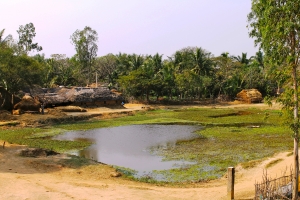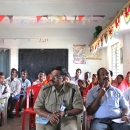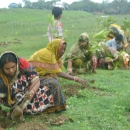Love for Mangroves is Love for God
Ashok Kumar Rout stoutly believes that mangroves will save his village from climate change
Location: Orissa, India. 28th Feb 2012
Globally, the effects of climate change, coupled with poverty and resource degradation, are being paralleled with rising vulnerability of people and environment, particularly in coastal ecosystems. Orissa, on the east coast of India, home to the Bhitarkanika mangrove ecosystem (the second largest in India) and Gahirmatha marine sanctuary (host to thousands of nesting Olive Ridley turtles), has been experiencing extreme contrasting weather conditions in the last few decades. Even as people struggle to develop resilience, conventional processes of adapting are proving insufficient
Kendrapara has been one of the worst hit districts in Orissa thus far. Land records from 1930 indicate that seven coastal villages (collectively known as Satabhaya) once existed in a corner of the village. By 2000, five of these villages had been swallowed up by the sea. The remaining two villages (along with several others along the coast) are in danger of a similar fate and have already re-located numerous times, leaving their original positions approximately 1km inside the Bay of Bengal.
Urmila Behera’s (Community Disaster Resilience Committee (CDRC) member) village has suffered from the damaging effects of sea level rise and erosion for years; where the water used to be half a days walk from the village it is now mere meters away. The authority’s solution was to build a sea wall of mud, despite the community’s disagreement. When a local NGO, Action for the Protection of Wild Animals (APOWA), formed CDRC, Urmila decided to become a committee member. She is proud of the fact that she can now help her community, particularly since she is doing work previously only done by men.
Sea levels in India will rise at the rate of 2.4 mm per year, according to the IPCC; in 2050, the rise will be 38cm. In addition to sea level rise and associated salt water intrusion and erosion, Orissa is frequently ravaged by cyclones, floods, storm surges and droughts. These claim thousands of lives and have resulted in hundreds of climatically displaced people referred to as ‘climate refugees’ or ‘environmental migrants’. Sonkar Gochayat’s family were among these migrants that moved from West Bengal to Orissa over 50 years ago in search of a more secure life. They moved to a deserted coastal area and started planting trees, particularly the mangrove species locally known as Habali (Thespesia populnea). The species attracts bees and Sonkar and his family now make a livelihood of harvesting honey, protected to some extent by the mangrove forest that they have planted.
At the ground level local communities are slowly building resilience to the impacts of climate change. Years ago Niranjan Swain, a community leader, and the rest of his village were forced to resettle, faced with a persistent problem of erosion that saw a rapid decrease in liveable land. Determined to prevent a repeat of the same problem, and based on the recommendations of neighbouring villages, Niranjan and his community planted and encouraged the growth of mangroves around their new village. The men formed a rotational guard system to protect their forests against wood cutters; a job that proved rather dangerous. Niranjan recounts how he was once knifed by a woodcutter whilst trying to prevent him from cutting down the trees. Although he was able to recognize the man from a neighbouring village and have him arrested, Niranjan bemoans the lack of help that authorities provide on the ground
Ashok Kumar Rout, a local community member, recounts how he hung onto a banyan tree for protection during the devastating supercyclone of 1999. When the danger passed he promised to plant 1000 trees in gratitude to Mother Nature for having saved his life. Like most of the coastal communities in this corner of Orissa, Ashok has come to understand the protective values of mangroves and is working ardently to restore and plant mangrove trees.
MFF India and APOWA are currently working on a Small Grant project Community stewardship in conservation, restoration and sustainable management of mangroves in Orissa to strengthen and sustain community stewardship in conservation, restoration and sustainable management of mangroves. The project takes into account the vulnerability of the region to natural disasters, the necessity for sustainable livelihood security for the local communities and conservation of ecologically significant natural resources


